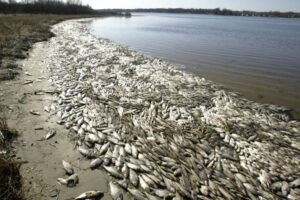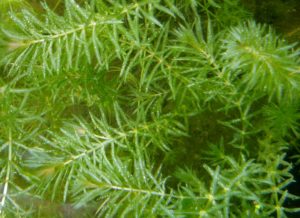
New York Invasive Species Research Institute
Aquatic Invasive Species
What are the threats?
New York ranks as the seventh U.S. state with the most water by area, providing abundant opportunities for human activities and habitat for aquatic plant and animal life. Home to an extensive canal system, international trade routes such as the St. Lawrence Seaway, and bordering two of the five Great Lakes, the threat and spread of invasive species is ever-present.
Aquatic invasive species (AIS) come in all forms and range from major bodies of water to roadside ditches. They not only threaten New York’s unique ecosystems, but also pose risks to public safety, recreation, agriculture, and other valuable resources. As the number of invasive species expands, our tools and knowledge to prevent and manage their threat are expanding too, but much remains unknown.
What is our role?
The New York State Water Resources Institute (WRI) at Cornell University is charged with addressing critical water resource problems in New York State and collaborates with federal, state, and academic partners. Both WRI and NYISRI support original research and the expansion of research capacity to better understand and manage aquatic invasive species threats. Below are several ongoing projects to address current aquatic invasive species threats to New York’s water resources. Also listed are the New York State Department of Environmental Conservation (NYSDEC) regional programs, featured topics, and additional resources.
Research projects:
Developing metrics to assess impacts of invasive aquatic species
Led by Wade Simmons and Bernd Blossey, Cornell University
This project will evaluate water chestnut (Trapa natans) invasions and management efforts to assess how the species and its control may affect native plants, amphibians, fish or invertebrates. The assessment methods developed will not be unique to Trapa, but can be applied in other aquatic systems and by managers without specialized scientific expertise or large budgets.
 Viral Hemorrhagic Septicemia Virus (VHSV) genetic diversity among invasive and native reservoir fishes of the Thousand Islands region
Viral Hemorrhagic Septicemia Virus (VHSV) genetic diversity among invasive and native reservoir fishes of the Thousand Islands region
Led by John Farrell, SUNY ESF
This project examines the hypothesis that VHSV genetic diversity is heterogeneous across years, sites and host species in the Thousand Islands region of the St. Lawrence River, and that both physical and biological structure of nursery bays will influence the viral genetic diversity achieved in different areas. A predictive model for VHSV will be developed.
Connectivity and spread patterns of the invasive aquatic plant Hydrilla verticillata in New York State
Led by David Lodge and Jose Andres, Cornell University
This project will investigate the genetic diversity, genetic relationships and patterns of gene flow between Hydrilla populations in New York and neighboring states, using landscape genomics to characterize the spatial spread of Hydrilla in NYS. In particular, this will evaluate the role of long-range dispersal in the invasion, such as plant fragments attached to boats or trailers, or tubers that are consumed and excreted by waterfowl.
NYSDEC regional programs:
WRI supports the NYSDEC Invasive Species Coordination Section in meeting the objectives of the New York State Aquatic Invasive Species Management Plan in DEC regions 7 and 9. An Aquatic Invasive Species Coordinator in each of these regions provides oversight, coordinates with stakeholders, and conducts projects for AIS prevention and control. Lindsay Yoder (Lindsay.Yoder@dec.ny.gov) serves as the AIS Program Coordinator for DEC Region 9 out of Buffalo, and Michael Robinson (michael.robinson@dec.ny.gov) is the AIS Program Coordinator for DEC Region 7 out of Syracuse.
Regional Project Map:
Featured topics:
Harmful Algal Blooms (HABs)
The below webinar was co-hosted by NYISRI and WRI during the ninth annual New York Invasive Species Awareness Week (June 10th, 2022). Presenters included leading professionals covering the latest science and management on harmful algal blooms and their intersection with invasive species issues.
Environmental DNA (eDNA)
The Laurentian Great Lakes are the most studied freshwater region when it comes to eDNA. But how complete are current aquatic species reference libraries? Can we confidently integrate invasive species detection with biodiversity assessments? This research summary explores the potential for eDNA metabarcoding to include non-native species in fish community sampling. Read more >>
Additional resources:
- NYS Water Resources Institute AIS Research
- NYS DEC’s AIS Management Plan
- NY Sea Grant AIS information
- NYS Federation of Lake Associations
- New York Invasive Species Clearinghouse
- New York State Partnerships for Regional Invasive Species Management (PRISMs)
- iMapInvasives (NYS reporting system)
FAQs:
iMapInvasives is the online reporting database for New York State. You can create an account for free and utilize this GIS-based data management system for reporting, tracking, and managing invasive species. iMapInvasives is used by natural resource professionals and citizen scientists, and enables real-time tracking of infestations, helping improve management decisions to protect native species and ecosystems.
Visit: https://www.imapinvasives.org/
There are a number of ways you can help prevent moving or introducing aquatic invasive species. Many new introductions are unintentional, and AIS can hitch a ride without you knowing. You can help protect New York State waters by remaining aware and responsible. Always clean, drain, and dry your boat and wet gear. Choose native species for gardens and don’t dump unwanted pets or aquariums. For more guidance on preventing the spread, visit: https://www.dec.ny.gov/animals/50121.html#How
Not all algal blooms are harmful and not all harmful blooms are toxic. Harmful algal blooms (HABs) refer to algal species that can produce toxins or cause other environmental or economic harm. Invasive species can interact with or influence algal blooms, and it can be hard to tell HABs from non-harmful algal blooms. With much still unknown, New York State has prioritized actions to address HABs.
> If you suspect a suspicious algal bloom, report it here, or email: HABsInfo@dec.ny.gov
> For more info on algal blooms in New York, visit: https://www.dec.ny.gov/chemical/77118.html
> To learn more about HABs and invasive species, check out this State of the Science webinar (2022)
> For regulations related to moving and/or possessing invasive species see the Part 575 FAQs
> For information about Prohibited and Regulated Plants in New York State, click here
> For information about Prohibited and Regulated Animals in New York State, click here









